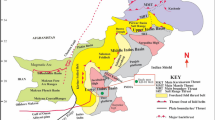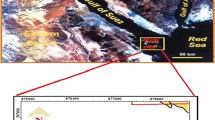Abstract
Jurassic Sangonghe sandstones (J1s) are prolific oil reservoirs in the Mosuowan area of the Junggar Basin. However, hydrocarbon exploration in deep-buried sandstones with depths > 4km would be highly risky due to the reservoir quality. Analysis of diagenesis can provide insight into controls on reservoir quality, which helps to reduce exploration risks and predict reservoir quality in perspective area. Routine core analyses and petrographic data were used to investigate diagenesis and their impact on reservoir quality of the J1s sandstones. J1s sandstones are mostly feldspathic litharenite and litharenite with an average composition of Q36F20R44. A wide range of porosity from 5.3 to 16% (average 11.6%) and permeability from 0.14 to 566mD (average 6.27mD) indicate that the reservoir has strong heterogeneity. Eodiagenetic events are characterized by mechanical compaction, chlorite grain coating, and calcite cementation. Mesodiagenetic events include feldspar dissolution, quartz overgrowth, kaolinite and illite precipitation, and ferrocalcite cementation. Mechanical compaction played a more prominent role in the reduction of porosity than cementation. Grain size and detrital component influence diagenetic compaction process which resulted in the difference in sandstone porosity reduction and variance in porosity-permeability correlation. Secondary porosity was generated mainly by feldspar dissolution. However, mass-balance calculations suggest almost equilibrium in aluminum of the system, indicating that burial dissolution contributes few to net porosity increase. Coarser-grained sandstones with more rigid grains and fewer ductile rock fragments are subject to less mechanical compaction which can preserve more intergranular pores. The coarser-grained sandstones have better reservoir quality than finer sandstones, which can be reflected by the higher slope in the porosity-permeability correlation.














Similar content being viewed by others
References
Bjørkum PA (1996) How important is pressure in causing dissolution of quartz in sandstones. J Sediment Res 66(1):147–154
Bjørlykke K (2014) Relationships between depositional environments, burial history and rock properties. Some principal aspects of diagenetic process in sedimentary basins. Sediment Geol 301:1–14
Bjørlykke K, Jahren J (2012) Open or closed geochemical systems during diagenesis in sedimentary basins: constraints on mass transfer during diagenesis and the prediction of porosity in sandstone and carbonate reservoirs. AAPG Bull 96(12):2193–2214
Bjørlykke K (1984) Formation of Secondary Porosity: How Important Is It?: Part 2. Aspects of Porosity Modification. AAPG Memoir 37: 277–286
Bloch S, Franks SG (1993) Preservation of shallow plagioclase dissolution porosity during burial: Implications for porosity prediction and aluminum mass balance. AAPG Bull 77(9):1488–1501
Bloch S, Helmold KP (1995) Approaches to predicting reservoir quality in sandstones. AAPG Bull 79(1):97–115
Chen JP, Wang XL, Deng CP, Liang DG, Zhang YQ, Zhao Z, Ni CY, Zhi DM, Yang HB, Wang YT (2016) Geochemical features of source rocks and crude oil in the Junggar Basin, Northwest China. Acta Geol Sin 90(1):37–67 (in Chinese)
Chuhan FA, Kjeldstad A, Bjørlykke K, Høeg K (2002) Porosity loss in sand by grain crushing- experimental evidence and relevance to reservoir quality. Mar Pet Geol 19: 39–53
Dutton SP (2008) Calcite cement in Permian deep-water sandstones, Delaware Basin, west Texas: origin, distribution, and effect on reservoir properties. AAPG Bull 92(6):765–787
Dutton SP, Loucks RD (2010) Diagenetic controls on evolution of porosity and permeability in lower Tertiary Wilcox sandstones from shallow to ultradeep (200 - 6700m) burial, Gulf of Mexico Basin, U.S.A. Mar Pet Geol 27(1):69–81
Ehrenberg SN (1989) Assessing the relative importance of compaction processes and cementation to reduction of porosity in sandstones: discussion; compaction and porosity evolution of Pliocene sandstones, Ventura Basin, California: discussion. AAPG Bull 73(10):1274–1276
Ehrenberg SN (1990) Relationship between diagenesis and reservoir quality in sandstones of the Garn Formation, Haltenbanken, Mid-Norwegian continental shelf. AAPG Bull 74(10):1538–1558
Folk RL (1974) Petrology of Sedimentary Rocks. Hemphill, Austin, p 182
Giles MR (1987) Mass transfer and problems of secondary porosity creation in deeply buried hydrocarbon reservoirs. Mar Pet Geol 4(3):188–204
Giles MR, De Boer RB (1990) Origin and significance of redistributional secondary porosity. Mar Pet Geol 7(4):378–397
Harris NB (1989) Diagenetic quartzarenite and destruction of secondary porosity: an example from the Middle Jurassic Brent sandstone in northwest Europe. Geology 17(4):361–364
Hayes MJ, Boles JR (1992) Volumetric relations between dissolved plagioclase and kaolinite in sandstones: implications for aluminum mass transfer in the San Joaquin basin. California, in D. W. Houseknecht and E. D. pittman. Origin, diagenesis, and petrophysics of clay minerals in sandstone. SEPM Special Publ 47:111–123
He S, Yang Z, He ZL, Wu HZ, Wang FR, Meng XL (2009) Mechanism of carbonate cementation and secondary dissolution porosity formation in deep-burial sandstones near the top overpressured surface in central part of Junggar Basin. Earth Sci - J China Univ Geosci 34(5):759–767 (in Chinese)
He DF, Zhang L, Wu ST et al (2018) Tectonic evolution stages and features of the Junggar Basin. Oil Gas Geol 39(5):845–860 (in Chinese)
Houseknecht DW (1987) Assessing the relative importance of compaction processes and cementation to reduction of porosity in sandstones. AAPG Bull 71(6):633–642
Islam MA (2009) Diagenesis and reservoir quality of Bhuban sandstones (Neogene), Titas Gas Field, Bengal Basin, Bangladesh. J Asian Earthsci 35:89–100
Irwin H, Curtis C, Coleman M (1977) Isotopic evidence for source of diagenetic carbonates formed during burial of organic-rich sediments. Nature 269:209–213.
Lai J, Wang GW, Ran Y, Zhou Z, Cui Y (2016) Impact of diagenesis on the reservoir quality of tight oil sandstones: the case of Upper Triassic Yanchang Formation Chang 7 oil layers in Ordos Basin, China. J Pet Sci Eng 145:54–65
Lai J, Wang GW, Cai C, Fan ZY, Wang SC, Chen J, Luo GX (2017a) Diagenesis and reservoir quality in tight gas sandstones: the fourth member of the Upper Triassic Xujiahe Formation, Central Sichuan Basin, Southwest China. Geol J 00:1–18
Lai J, Wang GW, Chai Y et al (2017b) Deep burial diagenesis and reservoir quality evolution of high-temperature, high-pressure sandstones: examples from Lower Cretaceous Bashijiqike Formation in Keshen area, Kuqa depression, Tarim basin of China. AAPG Bull 101(6):892–862
Lander RH, Laubach SE (2014) Insights into rates of fracture growth and sealing from a model for quartz cementation in fractured sandstones. GSA Bull 127(3-4):516–538
Lander RH, Walderhaug O (1999) Reservoir quality prediction through simulation of sandstone compaction and quartz cementation. AAPG Bull 83:433–449
Liao JD, Wang XL, Xiang BL, Cheng XS, Liu CM, Ling Y, Song YL (2004) Oil and gas origin and reservoir analysis of Mosuowan region in Junggar Basin. Nat Gas Ind 24(9):15–18 (in Chinese)
Loucks RG (2005) Revisiting the importance of secondary dissolution pores in tertiary sandstones along the Texas Gulf Coast. Gulf Coast Assoc Geol Soc Trans 55:447–455
Loucks RG (2006) Revisiting the Importance of Secondary Dissolution Pores in Tertiary Sandstones along the Texas Gulf Coast. Gulf Coast Association of Geological Societies Transactions 55:447–455
Morad S (1998) Carbonate cementation in sandstones: distribution patterns and geochemical evolution. International Association of Sedimentologists. Special Publ 26:1–26
Morad S, Ketzer JM, DeRos LF (2000) Spatial and temporal distribution of diagenetic alterations in siliciclastic rocks: implications for mass transfer in sedimentary basins. Sedimentology 47(S1):95–120
Morad S, Al-Ramadan K, Ketzer JM, DeRos, LF (2010) The impact of diagenesis on the heterogeneity of sandstone reservoirs: are view of the role of depositional facies and sequence stratigraphy. AAPG Bull 94(8):1267–1309
Niazi AMK, Jahren J, Mahmood I, Javaid H (2019) Reservoir quality in the Jurassic sandstone reservoirs located in the Central Graben, North Sea. Mar Pet Geol 102:439–454
Nguyen DT, Horton RA, Kaess AB (2016) Diagenesis, plagioclase dissolution and preservation of porosity in Eocene and Oligocene sandstones at the Greeley oil field, southern San Joaquin basin, California, USA. Geological Society London Special Publications (2016):SP435.14
Pittman ED (1992) Relationship of porosity and permeability to various parameters derived from mercury injection-capillary pressure curves for sandstones. AAPG Bull 76(2):191–198
Qiu NS, Yang HB, Wang XL (2002) Tectono-thermal evolution in the Junggar Basin. China J Geol 37(4):423–429 (in Chinese)
Rittenhouse G (1971) Mechanical compaction of sands containing different percentages of ductile grains: a theoretical approach. AAPG Bull 55(1):92–96
Sun J, Wu AC, Wang R, Zeng DL, Wang F, Xue JJ (2017) Characteristics and origin of deep tight sandstone gas reservoirs of the Jurassic Sangonghe Formation, Mosuowan area, Central Depression, Junggar Basin. J Palaeogeogr 19(5):907–918 (in Chinese)
Surdam RC, Boese SW, Crossey LJ (1984) The chemistry of secondary porosity, in Mcdonald DA and Surdam RC, eds., Clastic diagenesis: AAPG Memoir 37, 127–149
Surdam RC, Crossey LJ, Hagen ES, Heasler HP (1989) Organic inorganic interactions and sandstone diagenesis. AAPG Bull 73(1):1–23
Taylor T R, Giles M R, Hathon L A, Diggs TN, Braunsdorf NR, Birbiglia GV, Kittridge MG, Macaulay CI, Espejo IS (2010) Sandstone diagenesis and reservoir quality prediction: Models, myths, and reality. AAPG Bull 94(8):1093–1132
Walderhaug O (1996) Kinetic modelling of quartz cementation and porosity loss in deeply buried sandstone reservoirs. AAPG Bull 80(5):731–745
Wang JQ, Xu JH, Ren XC, Chi XQ, Shu PC, Liu X, Kong JH (2021) Diageneses and controlling factors of Jurassic Sangonghe Formation reservoirs on the west side of the hinterland of Junggar Basin. Acta Pet Sin 42(3):319–331 (in Chinese)
Wilkinson M, Darby D, Haszeldine RS, Couples GD (1997) Secondary porosity generation during deep burial associated overpressure leak-off: Fulmar Formation, United Kingdom Central Graben. AAPG Bull 81(5):803–813
Worden RH, Burley SD (2003) Sandstone diagenesis: the evolution of sand to stone Sandstone: Diagenesis: Recent and Ancient. 3–44.
Xi KL, Cao YC, Wang YZ, Wang YZ, Haile BG, Zhang XX, Zhang JH, Jin JH (2015) Diagenesis and porosity-permeability evolution of low permeability reservoirs: a case study of Jurassic Sangonghe Formation in Block 1, central Junggar Basin, NW China. Pet Explor Dev 42(4):475–485
Xu XT, Zhang LK, Ye MZ, Zhang LQ, Xiu JL, Zeng YP, Cao BF, Li C, Lei YH, Cheng M, Hu CZ (2021) Different diagenesis of deep sandstone reservoir and its relationship with reservoir property: case study of Jurassic in Zhengshacun area, central Junggar Basin. Nat Gas Geosci 32(7):1022–1036
Xi KL, Cao YC, Wang YZ et al (2015) Diagenesis and porosity-permeability evolution of low permeability reservoirs: A case study of Jurassic Sangonghe Formation in Block 1, central Junggar Basin, NW China. Petroleum Exploration and Development 42(4):475–485
Yuan GH, Gluyas J, Cao YC, Zhang C, Gluyas J (2015) Diagenesis and reservoir quality evolution of Eocene sandstones in northern Dongying Sag, Bohai Bay Basin, East China. Mar Pet Geol 62:77–89
Acknowledgements
We would like to thank PetroChina Xinjiang Oilfield Company for providing samples and data access and for the permission to publish this work.
Funding
This work is financially supported by the National Science and Technology Major Project (No. 2017ZX05001-002).
Author information
Authors and Affiliations
Corresponding author
Additional information
Responsible Editor: Domenico M. Doronzo
Rights and permissions
About this article
Cite this article
Shan, X., Guo, H., He, W. et al. Impact of diagenesis on the sandstone reservoir quality: a case study from the Lower Jurassic Sangonghe Formation, Junggar Basin, China. Arab J Geosci 14, 2022 (2021). https://doi.org/10.1007/s12517-021-08330-6
Received:
Accepted:
Published:
DOI: https://doi.org/10.1007/s12517-021-08330-6




